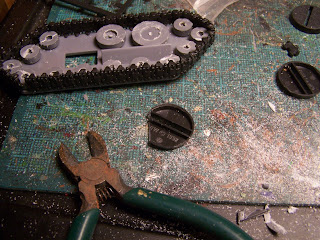
Okay, so once I got the chassis of my hellhound modeled (above) it was pretty beat up. Filing and carving and changing my mind about things left the glacis and top deck with all kinds of ugly scars. I wanted a way to cover up this mess without losing the authenticity of the model, and then I remembered that I'd always wanted to try modeling a tank with zimmerit.
Zimmerit is an nonmagnetic paint that the Germans used to apply to the hulls of their tanks. It seems that early in the war, the Germans had developed magnetic antitank mines that could be applied to the hull of a tank by an infantryman, and they were worried that other countries would also develop these mines and take out their tanks. So they painted the hulls of tanks at the factory with a substance made of nonmagnetic metals, sawdust and other stuff, then trowled up the surface in various different patterns to prevent magnetic mines from sticking. The magnetic mine scare turned out to be overblown, and in late 1944 the Germans stopped putting zimmerit on their tanks. But you can still see it in many historical photographs and also on surviving armored vehicles.
Even people who don't know about zimmerit and won't recognize it on a model, though, still have a vague feeling of having seen it and will perceive it as a "tanky" sort of thing even if they don't know why. It looks right, and for my purposes is perfect since the textured surface would cover my conversion mistakes.
Thanks to the Aeroscale message boards for this method of doing zimmerit with green stuff. There are many ways to model zimmerit, but this is the easiest one I've found and produces a good result.
First, roll out a pancake of greenstuff. I used a beer bottle, a hard surface, and plenty of water to keep it from sticking.

Next, drape your pancake over the part of the model to be coated with zimmerit.
 Tuck in and cut off the corners with a modeling knife. Press down the surface so that ridges and rivets show through from below. Cut around the edges of hatches, treads, intakes, and other places where zimmerit wouldn't be applied.
Tuck in and cut off the corners with a modeling knife. Press down the surface so that ridges and rivets show through from below. Cut around the edges of hatches, treads, intakes, and other places where zimmerit wouldn't be applied. At this point, about half an hour or less, the basic coat is done.
At this point, about half an hour or less, the basic coat is done.This method is eight-thousand times easier than most zimmerit modeling methods that require you to spread fiddly putties onto the surface of the model with a spreading stick. Your green stuff pancake is much easier to get to a uniform thickness than spread putty, and it has a working time of hours as opposed to the mere minutes or seconds that some putties allow.
Next, texture up the surface of the putty with a damp sponge. This simulates the actual texturing of the paint historically.

Now press the zimmerit pattern that you want into the surface of the putty with a damp tool of some kind.
I went with a common horizontal line pattern because it was easy to do with my hobby knife. But some people cut plasticard or use sculpting tools. The advantage of this being a SF game is that I don't have to worry about historical accuracy, just communicating the feel of zimmerit.
 The trick I learned at this point is that you're *stamping* and *pressing* the pattern into the surface rather than *raking* it into the putty. If you try to draw a tool across the surface, drag will cause the green stuff to wrinkle and bunch up. As usual, the tool has to be wet.
The trick I learned at this point is that you're *stamping* and *pressing* the pattern into the surface rather than *raking* it into the putty. If you try to draw a tool across the surface, drag will cause the green stuff to wrinkle and bunch up. As usual, the tool has to be wet. The finished zimmerit pattern from two angles, above and below.
The finished zimmerit pattern from two angles, above and below. I cut a chunk out of a corner below to represent a spot where the factory-applied paint had worn off. Also you'll notice I left some parts of the glacis uncovered, again to represent worn places. This type of wear is commonly seen in photographs of WWII zimmerit.
I cut a chunk out of a corner below to represent a spot where the factory-applied paint had worn off. Also you'll notice I left some parts of the glacis uncovered, again to represent worn places. This type of wear is commonly seen in photographs of WWII zimmerit. Finally, any gubbins that are going on top of the zimmerit need to go on while the putty is still pliable.
Finally, any gubbins that are going on top of the zimmerit need to go on while the putty is still pliable. With the turret on, the faint remains of the original turret ring under the putty are invisible.
With the turret on, the faint remains of the original turret ring under the putty are invisible.Next, gubbins.

























